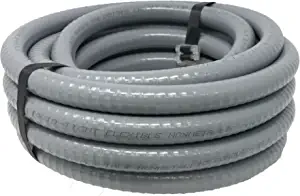When you are ready to begin wiring your home, garage, shed, or barn, you must first pick the sort of wiring you will use. Some wire includes a sheath covering that allows it to be stapled to wall studs and joists. These wires are all wrapped in the same sheath, but they are not without risk of harm if they come into touch with something that can cut into the plastic sheath and wires.
Protecting Wires From Damages
As a result, and if wiring must be protected from harm, another solution exists. Single strands of electrical wire dragged through metal conduit are one method. Many wires can be pulled from one electrical box to the next using these single strands inserted within the conduit.
Conduits range in strength from fairly sturdy to incredibly rigid conduit that you could drive over without damaging. You must select a conduit that meets your requirements while also adhering to the National Electrical Code.

Styles of Conduit
Conduit comes in a variety of forms and is used to run electrical wire in exposed areas of your home. It could be a basement, garage, barn, laundry room, or exposed spaces. Your home may have conduit installed inside the walls, allowing you to later draw extra circuits through the existing conduit runs. There are a few different types of wiring available within the conduits.
Stranded or solid wire, commonly of the THHN or THWN type, is usually drawn through the conduit. The size of the wire may vary depending on the amount of amperage required to supply the point being fed, which ultimately dictates the size of the conduit required.
Exterior Uses of Conduit
The conduit put outside must be rated for external use. The following are the various kinds and applications:
PVC conduit is frequently utilized in damp and subterranean situations. PVC fittings, connectors, couplings, and elbows are available for this type of conduit. They are simple to install using a cleaner and PVC adhesive. Because PVC conduit is not conductive, a green ground wire should always be run through the conduit for correct grounding methods at connection locations.
Flexible metal conduit is ideal for places where tight bends and close quarters make standard conduit difficult to bend. Water heaters, can lights, and attic vents are all common places where flexible metal conduit is used. The most common application for this sort of conduit is where there will be vibration: solid conduit will be shaken away, but flexible metal conduit will remain in place.
EMT conduit is lightweight, bendable, and used within walls. In addition, unlike IMC or rigid conduit, it is readily destroyed.
IMC conduit is a thicker, galvanized conduit that is ideal for outdoor installations. This is also a suitable option for exposed walls in basements, garages, barns, and other places where the conduit could be impacted or damaged.
The thickest and heaviest conduit is rigid metal conduit. It can be used to run wires under driveways, install service feeders, and in other more harsh conditions. Rigid conduit is more expensive than the other conduits described because it must be threaded on the end. Most utility companies use rigid conduit as the service entrance piping to provide the strongest and best installation capable of protecting the wiring and withstanding wind, falling branches, and storm damage. For a secure installation, most installations require the conduit to run through the roof.
All of the conduit types discussed above have a maximum permissible fill percentage.
What Are Proper Grounding Methods?
Grounding is a backup conduit for electricity from an outlet into the earth, where the electrical current can be safely diverted if the wire fails. Ground wires should be connected to outlet receptacles, switches, and fixtures in accordance with building requirements.
To know the pricelist of grout, Tile Grout Guaranteed Best Construction Material Philippines’ Prices
To know other construction guides, tips, and methodology for beginners, veterans, and contractors, please see here.
To know the flood prone areas in the Philippines, Top 10 Flood-Prone Areas to Live in the Philippines.
To know more about Concrete Hollow Blocks, Simple Reasons Why Hollow Blocks are Highly Used in the Philippines
To know more about Hammers and Nails, Tips for Guaranteed Best Technique for Hammering Nails
To know more about Tees and Wyes, What is the Guaranteed Best to Use: Sanitary Tee Vs Wye

